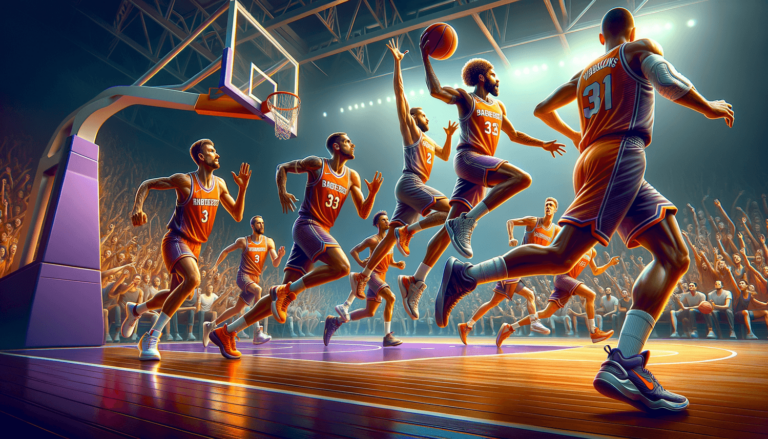
Have you ever found yourself wondering just how many players comprise a basketball team? Whether you’re a die-hard fan or just dipping your toes into the thrilling world of hoops, it’s essential to understand the basics of the sport, and that includes knowing how many athletes are on each side. In this informative and engaging blog post, we’ll unravel the mystery surrounding the number of players on a basketball team, both on and off the court. Get ready to up your basketball IQ and impress your friends at the next game night as we plunge into the exciting and energetic world of b-ball!
How Many Players Are on a Basketball Team?
Each basketball team has 12 to 15 players on their roster, with 5 players on the court at any given time during a game. Additionally, there are substitutes who can be rotated in and out of the game during breaks and timeouts. While the ideal number of players may vary depending on the team’s strategy and coaching preferences, this range has become the standard across most professional and amateur leagues.
A Deeper Dive into Team Composition
Understanding the various components of a basketball team is crucial to grasp the sport’s dynamics. The roster typically consists of players with diverse skills and roles. Let’s investigate how a basketball team’s puzzle pieces come together to form a cohesive and competitive unit.
Player Positions and Roles
Every basketball player on the court is assigned a particular position based on their physical attributes, skills, and the coaching strategy. Depending on the game plan, players may occasionally deviate from these roles:
- Point Guard (PG): Often regarded as the team’s “floor general,” point guards control the ball, make critical decisions, set up plays, and contribute to the team’s overall offensive strategy. Good ball-handling, passing, and leadership skills are essential attributes for this role.
- Shooting Guard (SG): This role is typically assigned to players with a knack for scoring. In addition to possessing excellent shooting skills from various ranges, shooting guards are often responsible for defending the opposing team’s top perimeter player.
- Small Forward (SF): Small forwards are versatile players who can handle numerous responsibilities on both offense and defense. They possess a solid skill set, including dribbling, passing, shooting, and rebounding. A good small forward can create mismatches that give their team tactical advantages.
- Power Forward (PF): Traditionally, power forwards were primarily responsible for rebounding and inside scoring. However, in modern basketball, players in this position have expanded their skill set and often attempt perimeter shots, making them “stretch-fours.”
- Center (C): Centers are generally the tallest and most physically imposing players. They guard their team’s basket and protect the paint with their shot-blocking abilities. Offensively, they score close to the hoop, utilizing size and agility to overpower opponents, and set screens for teammates.
Team Chemistry and Rotation
While having a good mix of skills and athleticism is essential for a basketball team, cultivating team chemistry is equally vital. A perfect blend of players with complementary skills can excel on the court together. Coaches need to strategize and adjust roster spots, distributing minutes to capitalize on the players’ strengths while mitigating weaknesses. Finding the right balance by rotating players and Lineups throughout a game helps maintain momentum and team stamina.
Understanding Bench Depth and Substitutions
The importance of having a deep bench cannot be understated. A basketball team’s reserves can make a significant difference in a game by providing valuable support and skill variations. This section explores how strategic fouls and adequate bench depth can impact the outcome of a game.
The Power of Substitutions
In basketball, managing player fatigue, foul trouble, and performance is a vital component of a coach’s job. One way to do this is through substitutions – this allows players to get rest, avoid further fouls, or enables coaches to alter the game plan. Coaches can also make situational substitutions to exploit specific matchups or execute particular strategies, such as inserting a defensive specialist, an elite shooter, or a reliable rebounder to make a game-changing play.
Dealing with Fouls and Foul Trouble
Accumulating fouls is an inevitable part of playing basketball. But when players accumulate too many fouls, it can create foul trouble that forces coaches to adjust their lineups. With a revolving door of players changing and adapting to the opponent’s strategy, teams can use roster depth to combat these moments. By having players with varying expertise levels, coaches can accommodate for foul trouble, while maintaining pressure on the opposition.
Analyzing the Effect of Injuries and Absence
Injuries and absences are recurring factors in the world of basketball. It’s essential for a team to prepare for such situations throughout a season. In this section, we’ll dissect ways teams adjust their lineups, roles and strategies when key players are unavailable.
Stepping Up When Stars are Injured
When a team loses a star player to injury or absence, they may initially struggle to adapt. However, this situation can also offer role players and untested prospects opportunities to step up and prove their worth. By redistributing the responsibilities equitably and focusing on teamwork, teams can overcome temporary setbacks.
Emergence of Unsung Heroes
It’s not uncommon for role players to rise to the occasion during a star’s absence, ultimately emerging as unsung heroes. These players may display offensive or defensive capabilities that were previously underutilized or develop new skillsets to benefit the team. They can become an integral part of the roster, even after the star player returns, contributing to the team’s success.
Assessing the Importance of Coaching Decisions
Coaches play a massive role in building and maintaining a successful basketball team. They execute predefined strategies, make in-game adjustments, and evaluate rotations to maximize the on-court impact of their roster. Let’s dive into the significance of coaching decisions within the context of roster management.
Making the Most of Available Talents
A good coach is essential in unlocking a team’s full potential. Each player’s unique skillset should be utilized strategically to maintain a well-rounded performance. Coaches constantly analyze and evaluate the performances of their players and decide on rotations, minutes, and game plans that exploit their opponent’s weaknesses and build on their team’s strengths.
Adapting to Various Game Scenarios
In basketball, no two games are the same. Each game presents different challenges, requiring coaches to tailor their strategies to gain an advantage. They may decide to emphasize perimeter shooting, increase defensive pressure, or opt for a slower half-court offense to control the pace. Coaching adaptability and deliberate decision-making are crucial in achieving success even when faced with less-than-ideal circumstances.
A Glimpse at the NBA’s Evolution and Roster Changes
Throughout the history of basketball, the game has witnessed dramatic shifts in playing styles, tactics, and team composition. By looking at the evolution of the NBA, we can understand the league’s fluctuations in roster count and its impact on the game.
Understanding the Expansion of Roster Size
When the NBA first emerged in 1946 as the Basketball Association of America (BAA), teams fielded ten players each. Over time, as basketball’s popularity boomed and the style of play evolved, the league adjusted the roster size to accommodate larger teams. The shift from ten to twelve players occurred in 1965, while the expansion to the current roster limit of fifteen took place in 2005. This change in roster size allowed teams to address fatigue and minimize the risk of overexertion on players, besides adding more strategic depth to the game.
Impact of the Two-Way Contract System
In 2017, the NBA introduced two-way contracts, offering teams even more roster flexibility. Under this system, teams can have two players on two-way contracts in addition to the primary 15-player roster. These players split their time between the NBA team and its G League affiliate, providing a developmental platform and bridging the gap between two leagues. This new roster arrangement allows teams to nurture talent, while having young players ready to step up when called upon.
Examining Roster Composition in International Basketball
Exploring roster rules and restrictions in international basketball provides a contrast to the NBA and showcases how different leagues around the world handle team composition and player allocations.
FIBA Regulations
International basketball tournaments governed by FIBA, like the Olympic Games and FIBA Basketball World Cup, have specific roster rules. FIBA permits each team to have twelve players, with no two-way contract system or similar arrangements in place. The FIBA roster structure highlights the importance of team depth and the versatility of players, requiring teams to strategize creatively with a more limited player pool.
EuroLeague Rules
The EuroLeague, one of the most prestigious basketball leagues outside the NBA, is characterized by its unique roster management approach. Each team can register up to sixteen players, with twelve of these players actively participating in each game. Coaches must submit a list of twelve players ahead of each match and can alter it from game to game. This roster fluidity enables coaches to design strategic plans for individual encounters while rotating players to prevent fatigue.
Ultimately, the number of players on a basketball team can vary depending on the skill set, chemistry, and coaching philosophy. Teams must strike a balance between versatility, depth, and player management to achieve success. As a basketball enthusiast, understanding the nuances of roster formats and compositions can foster a greater appreciation for the game – and enrich your overall hoops experience.
Exploring Basketball Team Composition at Different Levels
In addition to organized professional leagues, various other levels of basketball competition exist, each with distinct roster requirements and regulations. Let’s look at a few common levels of basketball play and understand how their rules may differ from professional leagues.
High School Basketball
High school basketball teams often have a roster size varying between 12 and 15 players. Coaching staff typically considers overall athleticism, skills, and academic eligibility when constructing a team. Most high school leagues follow the National Federation of State High School Associations (NFHS) rules. Notably, it’s common in high school basketball for coaches to maintain a junior varsity (JV) team alongside the varsity team, developing younger players’ skills in preparation for their transition into varsity play.
College Basketball
College basketball, governed by the National Collegiate Athletic Association (NCAA), allows both men’s and women’s teams to have a maximum of 15 players on their roster. College players are often recruited by top programs, and their academic performance weighs heavily on their eligibility for continued play. Similar to high school programs, college teams often have a separate squad, such as a reserve team, to develop less-experienced players who may not receive many minutes in a regular-season game.
Amateur/Recreational Leagues
Amateur and recreational basketball leagues typically cater to people of all ages and skill levels, facilitating enjoyable and low-key competition. Local leagues may have a flexible roster size to accommodate varying levels of participation, and the number of players on each team often falls within the range of 10 to 15. Unlike professional basketball, these leagues emphasize having fun, fostering camaraderie, and promoting overall physical fitness, while still allowing for the strategic team building and competitive spirit inherent to the game.
3-on-3 Basketball
3-on-3 basketball represents a variant of traditional 5-on-5 play. As the name suggests, each team features three players on the court and often includes one or two substitute players. Perhaps the most popular example of this format is FIBA’s official 3×3 competitions, which made its Olympic debut at the Tokyo 2020 Summer Games. With only half the usual team size, roster management becomes especially critical; players must be versatile, hardworking, and strategic thinkers to excel in the fast-paced, shortened-on-court environment of 3-on-3 basketball.
Mastering the Art of Team Building
Constructing a successful basketball team goes beyond simply assembling a talented roster; it involves thoughtful decisions and strategic management. Based on the level of play, following key factors contribute to a winning team composition:
Understanding Player Archetypes
Appreciating the unique characteristics each player brings to a roster is crucial for team building. Coaches and front office decision-makers should recognize strengths, weaknesses, and opportunities for development to form a harmonious team. By understanding player archetypes and matching them with complimentary teammates, organizations can build a cohesive, versatile, and competitive squad.
Importance of Leadership and Team Dynamics
Raw talent and skill matter, but they can only take a team so far. Experienced leaders who can inspire, motivate, and serve as models of hard work both on and off the court can elevate a team’s overall cohesion and effectiveness. Leadership can even come through younger, talented players who are eager to make their mark. Coaches, management, and players must work together to foster an atmosphere of unity, positivity, and dedication.
Building for the Future
When constructing a basketball roster, it’s vital to consider the team’s long-term development. As squads transition through various stages of competitiveness, ability to attract marquee names, and nurturing developing talent, striking a balance between immediate success and sustainable growth remains critical. Organizations must be patient, diligent, and forward-thinking to achieve both short-term and long-term goals.
Comprehending the different factors that go into creating a fully-functioning, cohesive basketball team enhances fans’ appreciation for the intricacies of the sport. As dedicated hoops enthusiasts, a genuine understanding of the game’s subtleties can further elevate your passion for this exhilarating and ever-evolving world of basketball.
FAQ Section
In this FAQ section, we cover some frequently asked questions related to basketball team composition and management. Explore a range of topics varying from player roles to technical fouls, providing you with greater insight into the intricate details of the sport.
1. How does a team choose its starting lineup?
A team’s starting lineup is chosen based on various factors, including the players’ skills, physical attributes, and the strategic approach the coach wants to implement. Additionally, a team’s starting lineup may vary depending on the opponent and specific game situations, requiring coaches to adapt and make adjustments as needed.
2. Can a team change its roster during a season?
Yes, teams can change their rosters throughout a season due to factors such as injuries, trades, or player suspensions. However, there are specific rules and restrictions, depending on the league, that regulate transactions, free agency signings, or call-ups from developmental leagues.
3. What is a Sixth Man?
A Sixth Man is the first player off the bench who joins the game as a substitute. Typically, this player has skills and experience akin to a starter, providing an instant impact by providing scoring, defense, or leadership when called upon.
4. How long can a player be on the bench before they are considered “benched”?
There is no specific duration that defines a player as “benched.” However, the term “benched” generally refers to when a player who was previously a significant part of the rotation receives little to no playing time. This could be due to performance issues, injuries, or the coach implementing a new game plan or lineup.
5. What is a ‘Small-Ball’ lineup?
A Small-Ball lineup is a tactical approach in which a team employs smaller, faster, and more agile players to increase the pace of the game, spread the floor, and improve ball movement. This strategy often sacrifices size and interior presence, focusing on perimeter play and causing mismatches for traditional, slower lineups.
6. How are coaches allowed to substitute during a game?
Coaches can substitute players during game stoppages, such as timeouts, fouls, or when the ball goes out of bounds. Coaches signal the substitution to the scorer’s table, and the waiting player enters the game once the referee permits them to do so.
7. What are technical fouls, and how do they affect team composition?
Technical fouls, or “techs,” are penalties assessed to players or coaches for unsportsmanlike conduct or other rule violations. Accumulating technical fouls can lead to penalties or even ejections, thereby affecting a team’s composition and forcing coaches to make adjustments by substituting or reworking their lineups.
8. Can a coach change the team captain during a season?
Though unusual, a coach can change the team captain during a season if necessary, based on changes in leadership qualities, team dynamics, or disciplinary reasons. Ultimately, the decision to change captains depends on the coaching staff and the organization’s overall strategy.
9. How do teams adjust when a star player retires or leaves?
When a star player retires or departs from a team, it can be a significant setback. However, teams adapt by focusing on player development, scouting potential replacements, implementing new strategies, or even rebuilding through draft picks and free agency signings.
10. Can a player be traded in the middle of a game?
A player can be traded while a game is in progress, but they’re usually not notified until after the game concludes. In such cases, the traded player would finish the game with their current team and then join their new team, subject to any league-specific trade completion procedures.
11. What is ‘Load Management’?
Load management is the practice of carefully monitoring and restricting a player’s playing time or practice workload to prevent fatigue, minimize injury risk, and maintain overall health, especially for star players or those with a history of chronic injuries.
12. How do teams manage their international players?
Teams accommodate international players by providing language support, assistance with cultural adaptation, and tailored player development programs. Additionally, teams respect national team commitments and coordinate with international federations to ensure their players’ well-being.
13. Can more than five players from one team be on the court at any given time?
No, only five players from
Featured Posts
- No pillar pages found.





